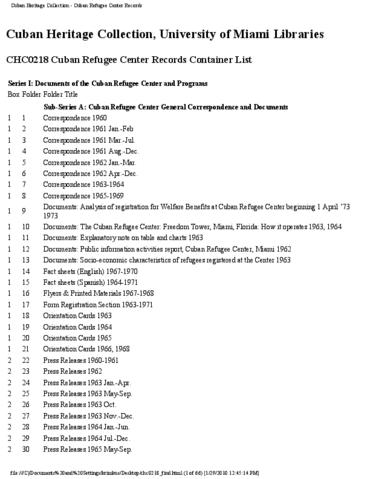Elementos de identidad
Nombre y localización del repositorio
Nivel de descripción
Colección
Título
Cuban Refugee Center Records
Fecha(s)
- 1960-1994 (Creación)
Extensión
109 Boxes
Nombre del productor
Historia administrativa
The Cuban Refugee Program was authorized by the President of the United States in February 1961. Federal assistance for Cuban refugees had begun in 1960 under President Eisenhower in response to the growing number of Cubans fleeing the Castro regime. President John F. Kennedy, recognizing that the situation was beyond the scope of individual states and volunteer agencies, assigned responsibility to the Secretary of Health, Education and Welfare (HEW), at the time Abraham Ribicoff, who delegated implementation and administration to William L. Mitchell, Commissioner of Social Security. The “Migration and Refugee Assistance Act,” enacted in 1962, provided the legislative basis for the program and authorized appropriations. The Florida State Department of Public Welfare, representing the federal government, set up an office in Miami for the assistance, child welfare services and medical care of Cuban refugees.
The Miami Cuban Refugee Emergency Center, located at the Freedom Tower, 600 Biscayne Boulevard, became the focal point of refugee registration, assistance, relief and resettlement, as well as coordination of government and independent agencies’ programs. Federal funding provided for the center’s operations, record keeping, publications, coordination of agencies and research on different aspects of the refugee situation, as well as for programs. The latter included financial assistance, educational loans, health care, adult education and re-training, resettlement and care of unaccompanied children. By 1962 between 1500 and 2000 Cubans were arriving weekly.
In 1963 the newly formed Welfare Administration succeeded Social Security in overseeing the Cuban Refugee Program. The decrease in influx of refugees following the cessation of regular flights and the implementation of programs such as home visits facilitated the transition from crisis response to a more efficient, better organized program.
In the years to come, however, the program would have to adapt to new emergency situations such as the arrival of Bay of Pigs Brigade 2506 prisoners in 1963 and the Camarioca boatlift of 1965. Perhaps the most taxing year was 1980 when the Mariel boatlift brought more than 125,000 Cubans to the United States. Simultaneously, Haitian refugees had started to arrive in growing numbers. The federal government declared a state of emergency and charged the Federal Emergency Management Agency (FEMA) with processing and assisting the entrants. On July of the same year the Cuban-Haitian Task Force (CHTF) was created to coordinate federal resources in support of county and state efforts, and to address community problems related to the influx of refugees into the Miami area, replacing FEMA in this capacity.
The Center closed its last location on Ponce de Leon Boulevard and 8th Street on July 1994, after more than three decades of providing assistance to thousands of refugees. Its archives were donated to Professor Juan Clark of Miami-Dade College who in turn donated them to the Cuban Heritage Collection.
Área de contenido y estructura
Alcance y contenido
The Cuban Refugee Center Records include correspondence, reports, publications, photographs, and clippings created and collected by the Cuban Refugee Center (CRC), in Miami in 1960 as part of a federal program to assist Cubans arriving at the United States as political refugees.
Sistema de arreglo
The Cuban Refugee Center Records are organized into seven series.
Please refer to the Finding Aid/Inventory section for more information about the organization of this collection.
Condiciones de acceso y uso de los elementos
Condiciones de acceso
This collection is open for research. Box 108 contains confidential documents from the collection and has been restricted.
Acceso físico
Acceso técnico
Condiciones
Requests to publish or display materials from this collection require written permission from the rights owner. Please, contact chc@miami.edu for more information.
Preferred citation: Cuban Refugee Center Records, Cuban Heritage Collection, University of Miami Libraries, Coral Gables, Florida.
Idiomas del material
- inglés
- español
Escritura(s) de los documentos
Notas sobre las lenguas y escrituras
Instrumentos de descripción
instrumento de descripción generado
Elementos de adquisición y valoración
Historial de custodia
Origen del ingreso
Gift of Juan M. Clark
Valoración, selección y eliminación
Acumulaciones
Elementos de material relacionado
Existencia y localización de originales
Existencia y localización de copias
Selected materials from this collection have been digitized.
https://digitalcollections.library.miami.edu/digital/collection/chc0218
Unidades de descripción relacionadas.
Descripciones relacionadas
Elemento notas
Notas especializadas
Identificador/es alternativo(os)
Área de control de la descripción
Reglas o convenciones
Fuentes
Nota del archivista
Processed by Isabel Ezquerra, Ximena Valdivia, and Duvy Argandoña, 2007. Retrospectively converted from HTML to EAD XML September, 2008 by Lyn MacCorkle and Kyle Rimkus based on a crosswalk by María Estorino. Updated by Juan A. Villanueva, March 2016. Date revised by Amanda Moreno, February 2018. Updated by Rebeca Gonzalez, May 2021.
Puntos de acceso
Puntos de acceso por materia
Puntos de acceso por lugar
Puntos de acceso por autoridad
- Cuban Refugee Center (Materia)

